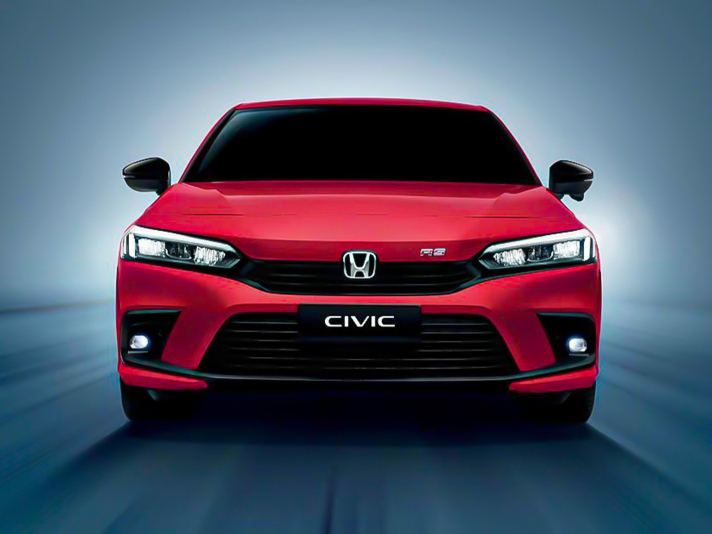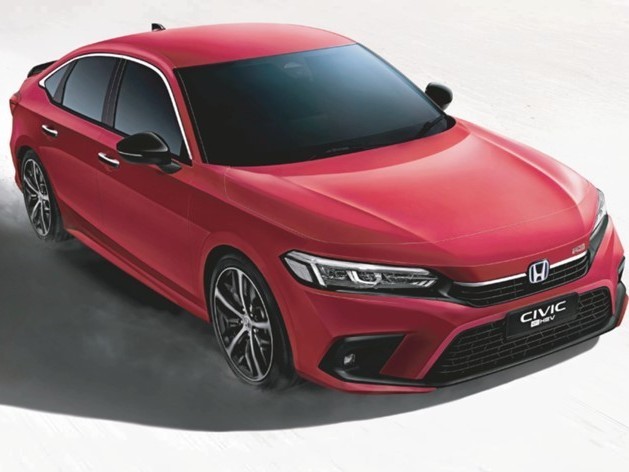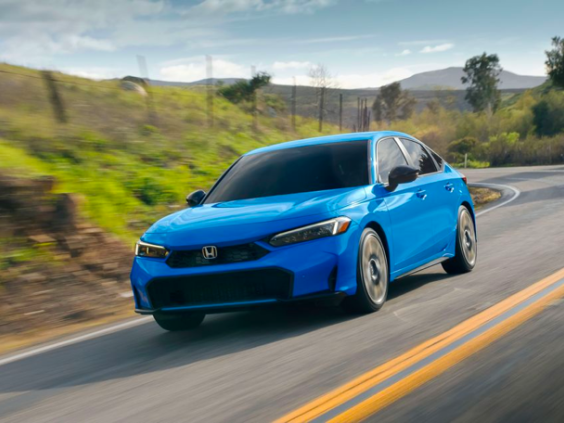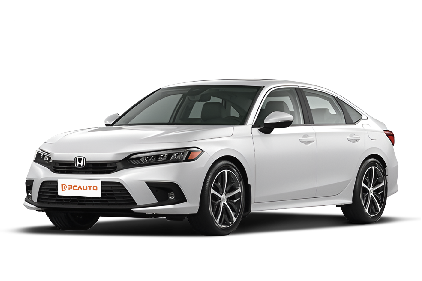Q
What Are the Dimensions of Honda Civic? Here Are the Full Specifications
The Honda Civic is a highly popular compact sedan. In terms of its body dimensions, it's 4,681mm long, 1,802mm wide and 1,415mm tall, with a wheelbase of 2,735mm. It offers a 5 - seat layout, and the rear - seat space is quite generous, which is suitable for daily family use.
There are multiple options for the powertrain. For example, there's a 1.5L turbo engine with a turbocharged intake form. It has a displacement of 1,498mL, a maximum horsepower of 182PS, a maximum power of 134kw and a maximum torque of 240N·m, paired with a CVT gearbox. There's also a 2.0L e:HEV version. Its fuel type is hybrid. The engine has a maximum horsepower of 143PS, the electric motor has a maximum horsepower of 184PS, and the gearbox type is E - CVT.
In terms of safety features, Honda Civic comes standard with ABS anti - lock braking, vehicle stability control, seat - belt reminder, lane - change assist, lane - departure warning system, active braking, 6 airbags, etc.
Its in - car features are also quite rich. A multi - function steering wheel, automatic headlights, and rain - sensing wipers are all standard. Different versions of the vehicle vary in aspects like seat adjustment and the number of audio speakers. For instance, seats in some models have 8 - way power adjustment, and the number of speakers is 4 or 8.
Special Disclaimer: This content is published by users and does not represent the views or position of PCauto.
Related Q&A
Q
What Segment Does Honda Civic Belong to?
The Honda Civic belongs to the C-Segment, which is in the compact car category. Compact cars typically have a body length ranging from 4.2 to 4.6 meters, focusing on being price - friendly, fuel - efficient, and convenient for daily use, with a design that balances practicality and driving pleasure.
The Honda Civic has a body length of about 4.6 meters. This size ensures ample interior space and handling flexibility. It offers a variety of power options, from naturally - aspirated to turbocharged engines, which can meet the needs of different consumers. The body design emphasizes aerodynamics and a modern look. With a young and stylish appearance, it's suitable for urban commuting and family trips. In the market, the Civic's direct competitors usually include other compact cars in the same class, such as the Toyota Corolla, Volkswagen Golf, Mazda 3, and Hyundai Elantra.
Q
What Is the Reslae Value of Honda Civic?
The Honda Civic maintains strong resale value in the used car market, consistently ranking among the best-retaining Japanese sedans in its class , particularly the newer tenth-generation (FC) and eleventh-generation (FK) models. Industry data shows Civic typically depreciates only 20%-30% over the first three years (depending on condition, mileage and market demand). For example, a 2020 Civic 1.5 TC originally priced around RM130k can still be priced at RM90k-RM100k in today's used market (varying by trim and maintenance history).
This exceptional value retention benefits from Honda's brand reputation, the appeal of its turbocharged engine (1.5L VTEC Turbo), and relatively low maintenance costs - though the base 1.8L naturally aspirated versions fetch slightly lower (yet still competitive) prices. Generally, low-mileage examples (under 15,000km annually) with complete service records and accident-free history are the most popular, while higher trims with Honda Sensing (like 1.5 TC-P) command premium resale prices over standard versions.
Additional factors affecting resale value include: preferred colors (white/gray being most popular), remaining factory warranty coverage, and aftermarket modifications (which may actually decrease value). Owners are advised to maintain regular authorized service center visits and keep complete documentation to maximize future resale potential.
Q
What's the Engine Displacement of Honda Civic?
The Honda Civic provides a variety of models with different displacements. The common displacements are 1.5L and 2.0L. When converted to CC (cubic centimeter, where 1L = 1000CC), they correspond to 1498CC and 1993CC respectively. The 1.5L models generally adopt the turbo - charged intake form, offering a fairly abundant power output, which can meet the needs of daily driving and some scenarios with certain power requirements. The 2.0L e:HEV RS model, on the other hand, is a gasoline - electric hybrid (HEV). It combines the advantages of the engine and the electric motor. While providing good power, it also boasts excellent fuel economy. Each model with different displacements has its own characteristics, and consumers can make a choice based on their own needs and preferences.
Q
What Engine Is Equipped by Honda Civic?
The Honda Civic offers multiple engine configurations. A common option is the 1.5L Turbo engine, featuring turbocharged intake with a displacement of 1498mL. It delivers a maximum horsepower of 182PS (134kW) at 6000rpm and peak torque of 240N·m between 1700-4500rpm. This inline-4 cylinder engine adopts an L-type cylinder arrangement.
Another available configuration is the 2.0L e:HEV RS, which utilizes naturally aspirated (NA) intake with a 1993mL displacement. The combustion engine produces 143PS (105kW) at 6000rpm and 189N·m of torque at 4500rpm. Combined with its electric motor, the hybrid system generates an additional 184PS (135kW) and 315N·m of torque.
These different engine options cater to varying consumer needs and driving preferences. The 1.5L Turbo provides robust power output, appealing to performance-oriented drivers, while the 2.0L e:HEV RS hybrid configuration balances adequate power delivery with superior fuel efficiency.
Q
What Is the Gearbox Type of Honda Civic?
The gearbox types of the Honda Civic vary depending on the model and year. Common transmission types include Continuously Variable Transmission (CVT) and Electronically Controlled Continuously Variable Transmission (E - CVT).
For gasoline - powered Honda Civic models, such as the 2025 Honda Civic 1.5L E, 1.5L V, and 1.5L RS, they are equipped with CVT. This type of transmission can provide a smooth driving experience and help optimize fuel efficiency. Unlike traditional transmissions, CVT doesn't have distinct gears and can achieve seamless changes in the transmission ratio according to driving conditions.
The 2025 Honda Civic 2.0L e:HEV RS is a gasoline - hybrid model, which uses E - CVT. This is specifically designed for hybrid vehicles. It combines the power of the engine and the electric motor, further improving fuel economy and providing a refined driving experience. The E - CVT manages the power distribution between the two power sources to ensure efficient operation in different driving scenarios.
Q
What Is the Pitch Circle Diameter of Honda Civic?
PCD (Pitch Circle Diameter) refers to the diameter of the central circle of the bolt holes in an automobile wheel hub. The PCD sizes of Honda Civic vary across different years and versions. Although the PCD dimensions may vary across different model years and versions of the Honda Civic, the given information does not explicitly specify the PCD. However, based on common wheel bolt-hole references for models like the 2022–2025 Civic, which have various tire sizes (e.g., 215/55 R16, 215/50 R17, 235/40 ZR18), the PCD in the Malaysian automotive market is typically 5x114.3mm—a widely compatible size.
For precise measurements, it is recommended to consult Honda authorized dealers or professional automotive workshops, as they can provide accurate PCD specifications for specific vehicle models.
Q
Is Honda Civic Equipped with Apple Carplay?
The currently available 11th-generation Honda Civic (Honda Civic 2023 FK) comes standard with Apple CarPlay wireless connectivity across the whole range (wired connection may also be retained in some models). Paired with a 9 - inch high - definition touchscreen, it seamlessly integrates navigation, music, and call operations for iPhone users.
As for the previous 10th - generation Civic (FC models), the mid - cycle facelift versions after 2019 (some 1.5 TC/TC - P models) also started to introduce Apple CarPlay. However, it should be noted that the early FC versions from 2016 - 2018 only support the Honda original system. If you want CarPlay, you may need to install a third - party module by yourself.
It is recommended that before buying a car, you confirm whether the function is available through the "Smartphone Connection" icon in the upper - right corner of the in - car screen or check the voice command button (with a microphone icon) on the steering wheel. If you're buying a used car, you can ask to test the compatibility by connecting your phone.
In addition, Honda Malaysia has been actively upgrading the in - car system in recent years. The new - generation Civic supports wireless Android Auto and maintains stable compatibility with the iOS system (it is recommended to use iOS 14 or later). In the future, system updates may further optimize the connection stability and response speed.
Q
What Is the Brand of Honda Civic's Tire?
The original - equipped tire brands adopted by the Honda Civic vary depending on different model years, vehicle types, and regional dealerships. Commonly, they include Michelin (such as Primacy 4 or Pilot Sport 4), Yokohama (like Advan dB or BluEarth - GT), and Bridgestone (Turanza T005A). These tires are characterized by their quietness, wear resistance, and wet - grip performance, which align with Honda's positioning for the Civic's well - balanced performance.
For example, the high - end 1.5 TC - P model might come with the higher - performance Michelin Pilot Sport series, while the entry - level 1.8S could be paired with more economy - oriented Yokohama tires. It's recommended that owners check the markings on the tire sidewall to confirm the specific model (e.g., 215/50 R17).
In addition, vehicles from different batches may have their tire brands changed due to supply - chain adjustments. If owners have higher requirements for the performance of the original tires, they can consult the authorized service center during maintenance or upgrade the tires on their own (such as choosing Continental or Goodyear). However, it's important to note that the tire size and load index must match the original specifications (most FK5 - generation models use 215/50 R17 or 235/40 R18) to ensure driving safety and maintain warranty rights.
Q
Is Honda Civic a Good Car? Learn the Pros and Cons Here
The Honda Civic is generally regarded as a good car with both advantages and disadvantages. Regarding its advantages, it has good performance. Some models are equipped with turbocharged engines, which can offer a pleasant acceleration experience. For example, the models equipped with a 1.5 - liter turbocharged engine can reach a maximum speed of 200 kilometers per hour. Its fuel economy is also quite good. The official combined fuel consumption of some models is about 6 liters per 100 kilometers, which helps to save the usage cost.
In terms of handling, the Civic benefits from its well - tuned suspension. The combination of the MacPherson front suspension and the multi - link rear suspension can provide a stable driving and riding experience and sensitive handling performance whether on city streets or highways. Safety performance is also one of its highlights. It comes standard with a series of safety features, such as multiple airbags, Anti - lock Braking System (ABS), and Electronic Stability Control, making you feel more secure on the road. The interior design is user - friendly, and the overall workmanship quality is usually reliable.
However, it also has some drawbacks. Some drivers may find the noise level, especially the road noise and wind noise at high speeds, a bit annoying. The rear - seat space may seem a bit cramped for taller passengers. In addition, compared with some competitors, its price may be relatively high. But overall, if you value performance, safety, and handling more than an absolutely quiet interior environment and the largest rear - seat space, then the Honda Civic is a good choice.
Q
What Is the Width of Honda Civic?
The width of the Honda Civic varies depending on different models and generations. Generally speaking, for the models listed here, the Honda Civic has a width of 1,802 millimeters. This dimension affects the vehicle's overall footprint on the road, affecting stability while driving, the space it takes up in parking lots and so on. It also has an impact on the interior space available to passengers. The wider the body, the more shoulder and elbow room passengers may have. Keep in mind that these dimensions may vary for newer or different versions of the Honda Civic.
Latest Q&A
Q
What is the engine power of the 2018 Volkswagen Vento?
The 2018 Volkswagen Vento available in the Malaysian market comes equipped with a 1.6-liter naturally aspirated four-cylinder engine, churning out 105 horsepower (77 kilowatts) and a peak torque of 153 Newton-meters. It's paired with either a 6-speed automatic or a 5-speed manual gearbox. This engine is known for its reliability and smooth power delivery, making it a solid fit for city driving and daily commutes. As Volkswagen's entry-level sedan, the Vento strikes a good balance between fuel efficiency and maintenance costs, aligning well with Malaysian consumers' focus on practicality and dependability. It's worth noting that while engine power is a key metric for vehicle performance, real-world driving feel is also shaped by factors like transmission tuning, vehicle weight, and aerodynamics. Prospective buyers should definitely take it for a test drive to get a sense of how everything works together. Volkswagen has a well-established dealer network in Malaysia, offering professional technical support and genuine parts availability, which helps ensure a stable long-term ownership experience.
Q
What is the price of the 2018 Volkswagen Vento?
In Malaysia's used car market, the 2018 Volkswagen Vento typically ranges from RM50,000 to RM70,000. The exact price depends on factors like condition, mileage, trim level, and location—high-spec or well-maintained examples might push close to RM80,000. As VW's entry-level sedan, the Vento stands out for its solid German-engineered chassis and the durability of its 1.6L MPI engine (105hp), paired with a 6-speed auto gearbox. It's a solid choice for city driving, returning around 6.5L/100km. Standard kit includes dual airbags, ABS, and ESP, with some variants adding reverse sensors, though tech features like a touchscreen infotainment system often require post-purchase installation.
It’s worth noting that VW’s resale value in Malaysia is somewhat impacted by perceived maintenance costs. Prospective buyers should definitely get a PUSPAKOM inspection, check the original service records, and consider cross-shopping against the same-year Honda City or Toyota Vios. Those Japanese models have bigger local followings and easier parts availability, but the Vento still holds an edge when it comes to high-speed stability.
Q
How much horsepower does a 2018 Vento have?
The 2018 Volkswagen Vento model available in the Malaysian market features a 1.6-liter MPI naturally aspirated engine delivering 105 horsepower and 153 Nm of torque. This engine prioritizes fuel efficiency and durability, making it well-suited for daily urban driving. It is paired with a 6-speed automatic transmission that provides smooth gear shifts. As Volkswagen's entry-level sedan, the Vento has gained popularity among Malaysian families for its solid German chassis tuning and reliability. While its power delivery isn't particularly impressive, it fully meets typical household needs and delivers commendable fuel efficiency. It's worth noting that different markets may offer distinct engine configurations, but the Malaysian market primarily features this 1.6L engine variant. When purchasing a used Vento, buyers should verify the specific configuration by checking the vehicle identification plate or the original owner's manual. Those seeking more power may need to consider higher-tier models, but the Vento delivers solid value for money and the expected build quality of a Volkswagen at this price point.
Q
Is the 2024 Mazda CX-5 petrol or diesel better?
The 2024 Mazda CX-5 is available in both gasoline and diesel variants in the Malaysian market. The optimal choice depends primarily on your driving needs. The gasoline model features 2.0L and 2.5L Skyactiv-G naturally aspirated engines, delivering smooth power output and lower maintenance costs. It excels for urban commuting and daily family use, particularly benefiting drivers who frequently make short trips. The diesel variant features a 2.2L Skyactiv-D turbocharged engine, delivering greater torque and superior fuel efficiency. It excels for long-distance driving or frequent cargo transport, though diesel vehicles typically carry higher purchase and maintenance costs. Given Malaysia's relatively low diesel prices, the diesel model may prove more economical over extended use for high-mileage drivers. Both models come standard with Mazda's i-Activsense safety suite, and their interior quality and handling performance are consistent. Note that diesel vehicles demand higher fuel quality standards; regular maintenance at authorized service centers is recommended. If you prioritize a quiet, comfortable driving experience, the gasoline model is preferable. For those focused on fuel efficiency and responsive power delivery, the diesel variant is worth considering.
Q
How many cc is the 2024 Mazda CX-5?
The 2024 Mazda CX-5 hits the Malaysian market with two petrol engine choices: the 2.0-litre and 2.5-litre Skyactiv-G naturally aspirated units. The 2.0L checks in at 1998cc, while the 2.5L comes in at 2488cc. Both powerplants leverage Mazda's clever Skyactiv tech, which strikes a nice balance between fuel efficiency and power delivery—ideal for both Malaysian city commutes and longer highway hauls.
Now, naturally aspirated engines are known for their linear power delivery at higher revs and generally lower maintenance costs, though they might not quite match turbocharged engines for low-end torque. But Mazda's done a solid job with the tuning here, so the CX-5 still feels plenty responsive in day-to-day driving.
For Malaysian buyers, the 2.0-litre variant makes a lot of sense if you're mostly zipping around the city. On the other hand, if you often carry extra passengers, load up the boot, or just want that little bit more grunt when you need it, the 2.5-litre is the way to go. Factor in the CX-5's reputation for sharp handling and that eye-catching Kodo design language, and it's definitely a strong contender in the mid-size SUV segment.
View MoreRelated News

Honda Civic Interior Revealed: A Comprehensive Analysis of Civic’s Interior Charm
Kevin WongJul 10, 2025

Honda Civic Price Revealed: The Most Detailed Buying Guide!
AshleyApr 8, 2025

Whether it's about appearance or handling, why do young people all like Honda Civic?
WilliamSep 24, 2024

2022 Honda Civic: Hybrid car with the fastest acceleration, lowest fuel consumption, who says eco-friendly cannot be fast
JohnSep 3, 2024

2025 Honda Civic debuts, minor changes in appearance, has 1.5 Turbo model been discontinued?
LienMay 22, 2024
View More













 Cars
Cars




Pros
Cons